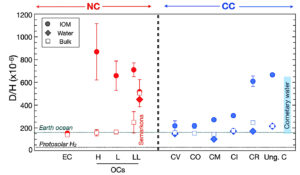Piani, L. ; Marrocchi, Y. ; Vacher, L.G. ; Yurimoto, H. (2021) Earth and Planetary Science Letters, 567, 117008
Voir en ligne : https://doi.org/10.24396/ORDAR-61

Abstract :
Chondrites are rocky fragments of asteroids that formed at different times and heliocentric distances in the early solar system. Most chondrite groups contain water-bearing minerals, attesting that both water-ice and dust were accreted on their parent asteroids. Nonetheless, the hydrogen isotopic composition (D/H) of water in the different chondrite groups remains poorly constrained, due to the intimate mixture of hydrated minerals and organic compounds, the other main H-bearing phase in chondrites. Building on our recent works using in situsecondary ion mass spectrometry analyses, we determined the H isotopic composition of water in a large set of chondritic samples (CI, CM, CO, CR, and C-ungrouped carbonaceous chondrites) and report that water in each group shows a distinct and unique D/H signature. Based on a comparison with literature data on bulk chondrites and their water and organics, our data do not support a preponderant role of parent-body processes in controlling the D/H variations among chondrites. Instead, we propose that the water and organic D/H signatures were mostly shaped by interactions between the protoplanetary disk and the molecular cloud that episodically fed the disk over several million years. Because the preservation of D-rich interstellar water and/or organics in chondritic materials is only possible below their respective sublimation temperatures (160 and 350–450 K), the H isotopic signatures of chondritic materials depend on both the timing and location at which their parent body formed.



